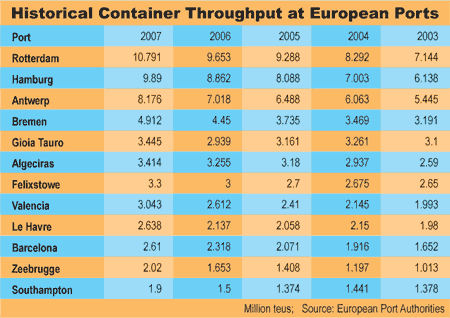
TRANS-ATLANTIC TRADE - Europe looks to new projects to handle anticipated box growth
European containerport numbers are still on the rise and authorities look to new projects to absorb future growth.By George Lauriat, AJOTVirtually every European port in the Northern Range from Le Havre, in the South, centrally located Rotterdam, British ports like Felixstowe & Southampton, and the German ports of Hamburg & Bremerhaven, experienced significant growth in 2007. Further, even with the economic uncertainty in the United States, box totals continue to rise as the European ports look for means to accommodate projected growth.
Unquestionably, this is new economic ground for most. Since the 2nd half of 2007, increased imports from the US to Europe have added to the rising, albeit at a slower pace, box total of imports from Asia. Some of the rise in US exports to Europe is due the result of poor weather that impact agriculture throughout the Continent. US grain exports are way up to Europe – over 330% January ‘07 compared to January ’08, in dollar terms. But overall, the depreciation of the dollar against the Euro has kicked out a wide variety of exports that has cut into the traditionally large trade deficit that the US has with its European trade partners. The US trade deficit with the EU (European Union) in 2005 was over $123 billion. In 2007 the tally was trimmed to $107 billion with close to $10 billion coming last year. Most of the change was due to US export growth as imports continued to increase. However, as the pace of US exports increases and the US dollar weakens the question of whether of European imports to the US market will remain strong is cause for concern. Certainly the mix of agricultural and other neo bulk exports, like wastepaper is of less dollar value (and generally more weight) than the inbound goods from Europe. In box terms, securing enough containers to satisfy US export demand to Europe is a major problem that will squeeze the numbers. With the anticipated US economic turn (although most economist say slight) around in the 2nd quarter of ’08, how much will change in Europe? The European ports are building to accommodate future Asian trade. The recent shifting of slots from US trades (specifically Asia-US West Coast) has certainly justified the strategy. But is the US increase in exports to Europe an anomaly driven entirely by the weak dollar or a long-term readjustment in trade patterns?







